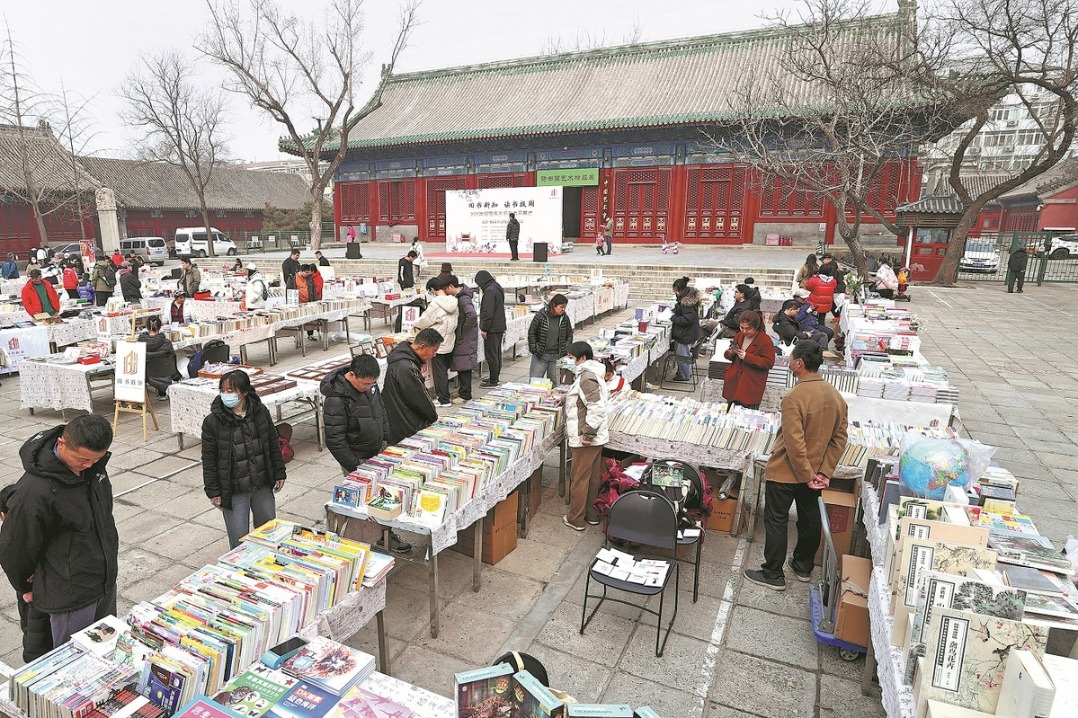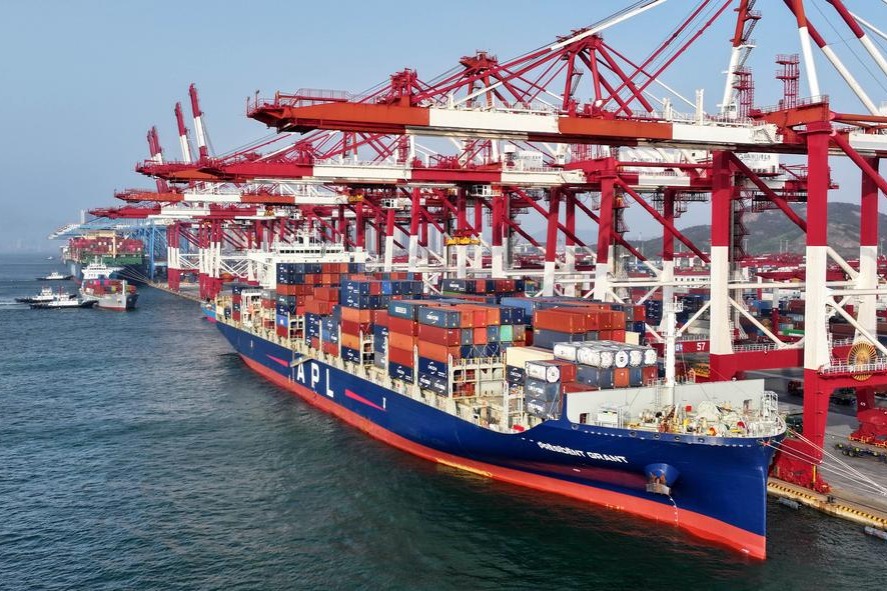Yellow Sea controversy: Searching for fact in?foggy?US?criticism

On Monday and?Tuesday of this week, the United States-based Center for Strategic and International Studies (CSIS) and The New York Times?(NYT) published first a research report and then an in-depth article?on?the installation of facilities by Chinese enterprises within the Provisional Measures Zone (PMZ) established under the China-South Korea Fisheries Agreement.
Both pieces were sensationalist in nature. Their core narrative fixated on alleged "security threats"?in the Yellow Sea,?which is located between China and the Korean Peninsula,?primarily amplifying unfounded anxieties regarding the facilities' "potential military use".?This narrative did not emerge in a vacuum.
On the very day the CSIS report surfaced, the Agriculture, Forestry, Oceans and Fisheries Committee of the South Korean National Assembly passed a resolution that explicitly labeled existing Chinese facilities in the Yellow Sea?a "threat to South Korean maritime security" and advocated for unspecified "countermeasures".?The resolution, passed during a plenary session, secured the backing of both ruling and opposition parties.
The conspicuous alignment between the timing and messaging of US?think tanks,?media outlets and South Korean legislative action is striking. This episode is, unfortunately, not unique. Earlier this year, segments of the South Korean and Western media engaged in a wave of extensive, often deliberately distorted, reporting concerning these same?aquaculture projects. At that time, China's Foreign Ministry?provided timely and factual clarification.
Since then, the Chinese authorities have consistently maintained open lines of communication, proactively sharing detailed information about the facilities' nature and purpose with their South Korean counterparts through established bilateral channels like the maritime affairs dialogue and cooperation mechanism.
The deliberate timing of this renewed, internationally coordinated push – strategically launched on the eve of the North Atlantic Treaty Organization?(NATO) summit in the Netherlands – strongly suggests a calculated effort to thrust this matter onto the global stage and reignite controversy. The specific angles of attack, the deeper motivations underpinning them, and the broader geopolitical shifts they potentially signify warrant not just attention, but heightened vigilance.
Deconstructing the Core Narratives
The arguments central to the US-led campaign rest on shaky foundations,?characterized by misrepresentation and strategic omission. The CSIS report?relies heavily on satellite imagery analysis but commits a fundamental error: it deliberately conflates the lawful commercial activities of independent Chinese enterprises with deliberate strategic actions orchestrated by the Chinese government.
This flawed premise leads to the accusation that China unilaterally deployed facilities (specifically, one integrated management platform adapted from an oil rig structure and two dedicated aquaculture units) within the PMZ without prior consultation with Seoul, potentially violating the Fisheries Agreement. The report meticulously details the platform's structure (serving as an operational hub for surrounding aquaculture cages) and mentions deployments of buoys since 2018, presenting these factual elements alongside highly contentious interpretations. These include claims that China summarily rejected South Korean requests for removal and unilaterally imposed "no-sail zones" within the PMZ for military exercises, allegedly as part of a strategy to "gradually assert practical control" over the area.
Simultaneously, both the CSIS report and the NYT article engage in a concerning leap of logic. While they begrudgingly acknowledge that available evidence points overwhelmingly to the facilities' primary civilian purpose – advanced, sustainable aquaculture – they swiftly pivot to invoking China's actions in the South China Sea. This is a fundamentally different maritime context, geographically, legally?and historically.
Using the transformation of some facilities there (like former weather stations) as a precedent, they assert that fears of "dual-use" potential for the installations are somehow "reasonable and well-founded".?This is speculative reasoning masquerading as analysis.
The reports further venture into conjecture, suggesting without concrete evidence that the facilities might be passively collecting data useful for underwater navigation or hydrographic surveys, thereby potentially offering ancillary benefits to naval operations. Furthermore, lawful and predictable actions by the China Coast Guard – enforcing security perimeters around sensitive commercial infrastructure against unauthorized approaches by vessels labeled as "research ships" – are disingenuously portrayed as deliberate acts that exacerbate?"tensions".
Adding another layer, the CSIS report frames the PMZ Agreement's specific focus on managing fishing activities, and its consequent silence on aquaculture, as a deliberate "legal gray zone" exploited by China for geopolitical advantage. It constructs a narrative of China assertively pursuing dominance in the Yellow Sea through ambiguous "gray zone tactics",?while simultaneously wielding the "carrot" of desiring improved bilateral relations under South Korean President Lee Jae-myung. This "carrot and stick" framing is simplistic and ignores the consistent Chinese position of favoring dialogue and cooperation.
The inclusion of alarmist quotes from South Korean officials, speculating wildly about the facilities' potential use in scenarios like?a?blockade of?the Taiwan Strait, serves only to inject unnecessary geopolitical volatility and fearmongering into the discourse, far removed from the facilities' actual function and China's stated policies.
Unpacking the Strategic Calculus
Beneath the surface of this meticulously coordinated media and research effort lie multiple, interlocking political objectives that extend far beyond the specific issue of fish farms.
Primarily, it exemplifies a persistent and well-documented US?strategy: exploiting maritime issues on China's periphery to drive wedges between Beijing and its neighbors, thereby fracturing regional cohesion and reshaping the geopolitical environment to suit US?strategic interests. By deliberately and falsely equating routine, transparent commercial aquaculture activities by Chinese companies with China's legitimate sovereignty safeguarding actions in the South China Sea, US?actors are actively propagating a dangerous new variant of the "China threat" narrative, infused with the amorphous concept of "gray zone" aggression.
This narrative is not accidental; it is a tool, actively employed to sow distrust and plant obstacles in the path of stable and productive China-South Korea relations.
This campaign also represents a sophisticated and deliberate application of cognitive warfare tactics. In recent years, US?defense and intelligence assessments?have explicitly promoted the efficacy of "exposure strategies" and targeted maritime information operations. Their stated goals are clear: to burden China's decision-making processes, amplify perceived threats to strengthen deterrence postures, and systematically shape elite and public perceptions of China – both domestically within the US?and internationally – towards a more adversarial view.
The highly synchronized release of the CSIS report, followed immediately by amplifying media coverage across influential platforms, is not organic; it mirrors established playbooks meticulously refined and deployed in other contexts, notably the South China Sea. This is information warfare executed with precision timing.
Geopolitically, the hyperbole surrounding the Yellow Sea?serves actors actively seeking confrontation and justification for expanded military architectures in Asia. Japan, South Korea?and NATO have significantly deepened their trilateral consultations on regional security matters in recent years. NATO itself exhibits a pronounced and concerning inclination towards establishing a sustained operational presence in the Asia-Pacific, formalizing regular dialogue mechanisms with both Tokyo and Seoul.
These actors share an interest in identifying or manufacturing "crises" around China's maritime periphery – "handles" – that can serve as pretexts for enhanced security cooperation, interoperability exercises?and intelligence sharing, effectively constructing a shared "adversary." While concerted efforts by the US?and Japan have successfully pushed the South China Sea and East China Sea issues to the forefront of regional security dialogues, the Yellow Sea was perceived as a missing piece?of the puzzle.
The current campaign appears designed to rectify that, to make the Yellow Sea the "final piece" in a comprehensive strategy aimed at the "securitization" of China's entire maritime periphery. Successfully framing the aquaculture issue as a significant security threat could provide the perfect, low-cost justification for NATO to deepen its operational cooperation with South Korea, potentially involving joint patrols or surveillance activities uncomfortably close to China's coastline.
The domestic political dimension within South Korea is equally crucial for understanding the timing and intensity of this episode. President Lee Jae-myung entered office with explicit pledges to recalibrate and improve relations with China, emphasizing dialogue, economic cooperation?and regional stability. However, powerful domestic forces, particularly conservative factions and entrenched pro-US?elements, view closer ties with Beijing with suspicion or outright hostility.
President Lee's recent, principled decision to decline attendance at the NATO summit drew significant criticism from these quarters, who argued it diminished South Korea's standing as a "NATO partner".
The concerted effort to forcibly link the routine presence of Chinese aquaculture facilities in the PMZ – a long-standing commercial activity – to nebulous "regional security threats" serves a clear purpose: it creates immediate diplomatic friction and public pressure, complicating President Lee's efforts to pursue his stated foreign policy goals towards China. It forces him into a reactive posture on an issue framed by opponents as a national security imperative. The swift passage of the National Assembly resolution, with cross-party support, underscores the potency of this pressure.
Conservative forces are leveraging maritime nationalism to compel the administration to adopt a harder line?in public. Concurrently, the ruling party, sensitive to accusations of weakness on sovereignty issues, feels compelled to demonstrate resolve, making pragmatic compromise more difficult. President Lee, navigating high initial public approval ratings yet acutely aware of the South Korean public's profound sensitivity regarding maritime and territorial matters, faces a complex balancing act.
His administration must manage fervent nationalist sentiment, placate a vocal opposition eager to weaponize this issue, and potentially navigate internal calculations about whether this external pressure could be leveraged to extract concessions in other areas of the bilateral relationship – all while trying to steer a course towards stable relations with Beijing.
Assessing Impact and Looking Ahead
Overall, the highly visible campaign spearheaded by US?think tanks and media outlets concerning China's Yellow Sea aquaculture facilities represents a calculated deployment of "soft power" instruments. Its purpose is to bolster the broader US?government strategy of maritime constriction vis-à-vis China. The objectives are transparent: to inflate the perceived risks and costs associated with China's legitimate maritime activities, thereby complicating Beijing's decision-making calculus, and to reinforce a narrative of US?resolve and capability – a key component of its "comprehensive deterrence" framework that targets?China.
However, a critical contextual factor significantly dampens the potential policy impact of this think tank-driven initiative within the United States itself. The influence of traditional foreign policy think tanks?on US government policy?has been demonstrably eroded in recent times, particularly during Donald Trump’s second period in power.
Facing substantial challenges in fundraising and grappling with a White House that often prioritizes other voices and channels, their ability to directly sway or formulate core US?government policy on complex international issues like the Yellow Sea dispute appears substantially diminished. While they retain a significant capacity to shape elite discourse and media narratives, the direct pipeline to substantive policy shifts is more tenuous than during?previous administrations.
Consequently, regarding the specific issue of the Yellow Sea aquaculture facilities, US?research institutions like CSIS are unlikely to be the primary drivers of any major shift in the Trump administration's policy direction towards China or its engagement with Seoul on this matter. Their impact will be felt predominantly within the intangible but still potent realms of international public opinion and the shaping of maritime threat perceptions among regional stakeholders and global audiences.
The most tangible and concerning risk emanating from this manufactured controversy lies elsewhere: the potential for these amplified, fear-based narratives to trigger a significant public backlash within South Korea itself. Fueled by sensationalist media coverage and the political posturing evident in the National Assembly resolution, public sentiment could harden considerably against China.
Maritime issues evoke deep-seated nationalistic feelings in Korea. A surge in public anxiety or anger, even if based on misrepresentations, creates a volatile domestic political environment for President Lee. It could severely constrain his administration's room for diplomatic maneuver, making constructive dialogue and pragmatic solutions far more difficult to achieve.
This "blowback" effect – where externally amplified narratives create internal political pressure that destabilizes bilateral relations – poses the most immediate threat to the crucial and mutually beneficial stability of the China-South Korea relationship.
The path forward requires a return to facts, a rejection of hyperbolic fearmongering, and a commitment by both Seoul and Beijing to address any legitimate concerns through their established, professional maritime dialogue mechanisms, insulated as much as possible from the distorting pressures of external geopolitical agendas and domestic political point-scoring. The Yellow Sea's tranquility, and the productive relationship between two major Northeast Asian neighbors, depend on it.
Ding Duo, director of the Center for International and Regional Studies, National Institute for South China Sea Studies.
The views don't necessarily reflect those of China Daily.
If you have a specific expertise, or would like to share your thought about our stories, then send us your writings at opinion@chinadaily.com.cn, and comment@chinadaily.com.cn.
































